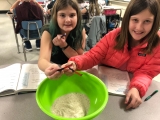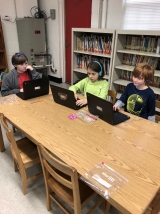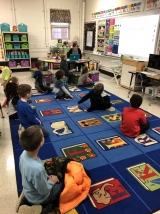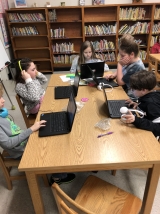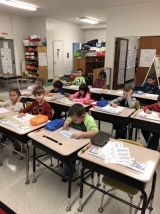-
Category 3
Selected in 2019
-
Grades: pre k - 5
School Setting: rural
Town Population: 16,473
Student Enrollment: 203
Student Demographics:
Black/African American: 5.7%
Teacher/Student Ratio: 1:14.5
White/Caucasian: 89.8%
Hispanic: 4.5%
Hawaiian/Pacific Islander: 0%
Asian: 0%
Native American: 0%
Other: 0%
% Reduced Lunch: 53%
% ELL Learners: 0%
Founded: 1950 -
PRINCIPAL:
Rena McKnight -
CONTACT:
988 Highway 210
DYERSBURG, TN 38024
731-285-1994
rmcknight@dyercs.net
Holice Powell Elementary School
DYERSBURG, TN
We believe we must meet the needs of the entire child.
- Describe specific programs in place to ensure that families are involved in the success of your school and students.
- Family involvement in a child’s education is a key to a successful school. Some of our programs that encourage involvement are literacy nights, Back to School Bash, parent teacher conferences, STEM nights, and PTO. Families are also invited to the school on a regular basis for awards and music programs. It is important that families are given the opportunity to celebrate their child’s successes. Our Back to School Bash is geared toward welcoming families into our school and starting the school year off in a positive way. Our Family Literacy Night engages families in literacy activities while also providing a STEM activity, art activity, and snack. STEM Nights are geared toward encouraging students and parents to learn together while exploring science, technology, engineering, and mathematics. All of these activities are provided at no cost to the families. Other programs used to assist in communication with parents include weekly progress reports, newsletters, and social media.
- Describe the most successful activity your school has initiated to strengthen ties to your community.
- Starting our Back to School Bash at HPS has strengthened our ties to the community. By hosting this yearly event for our students, their families, and other community members, we start our school year in a positive way. We are able to integrate the entire community in this event. Our community partner, Dyersburg Electric, provides hot dogs to all attendees which also meets a basic need for them. Our four local churches provide chips and more importantly prayers. We also receive donations from other local businesses. We are able to provide a meal and a time of fun to our students, their families, and community members in a relaxed atmosphere. Staff work together to entertain students with outdoor games and activities. We end the night with our first PTO Meeting of the year and give an insight into the many activities we have planned. This event involves all of the major stakeholders in the education process: students, parents, teachers, businesses, churches and community partners.
- Describe your philosophy of school change or improvement.
- Our philosophy of school change is one in which all stakeholders invest. It is one in which students, parents, teachers, staff, and community members join as a unified team with one common goal. Our philosophy is centered on the belief that all students can learn, grow, and thrive when provided a safe, nurturing learning environment tailored to their needs. We believe we must meet the needs of the entire child. At HPS, we focus on meeting the students’ basic needs first. After the basic needs are met, we then turn our focus to academic needs. Through purposeful data collection, specific student weaknesses and strengths are identified. An educational plan is put into place to ensure all students reach their greatest potential. All staff members in our school are invested in EACH child. We all work to develop relationships with all students.
- What are your school’s top two goals for the next year?
-
One major goal for our school is to improve attendance. We are working to motivate students to attend school by rewarding them and celebrating their successes. We are striving to make our school inviting and welcoming to encourage student attendance.
Another very important goal we have set is to increase the percentage of students performing at the on-track or mastery level on the English/Language Arts portion of our state-mandated test.
- What is the single most important factor in the success of your school that others could replicate?
-
We believe the single most important factor in our success is setting high expectations for all of our students. Every student at Holice Powell Elementary is held accountable for these expectations by the entire school staff.
We have high expectations for all of our students regardless of their socio-economic status. We work to motivate these students to reach their full potential. In addition to having high expectations and accountability for our students, all staff members have high expectations for one another and strive to hold each other accountable.
- Describe the program or initiative that has had the greatest positive effect on student achievement, including closing achievement or opportunity gaps, if applicable.
-
Collaboration among knowledgeable colleagues has most affected student achievement at Holice Powell. Being able to collaborate daily with teachers who are informed of state standards and plan using those standards have been invaluable. Our teachers have learned so much by watching strong teachers deliver lessons. A curriculum does not compare to seeing teachers help students. Our school has the hardest working, most knowledgeable teachers, who are willing to share ideas, struggles and strategies with one another. We offer specialized instruction designed to meet the needs of each and every student in our classrooms. Achievement gaps are closed due to instruction that is developed to meet individual needs.
- Explain how ESEA federal funds are used to support your improvement efforts.
-
These funds are used to improve the academic performance of all students, particularly the lowest-achieving students, in the school. ESEA federal funds allow us to have additional staff members, which helps us to teach students in small groups and individually. These funds are used to purchase supplemental instructional resources and materials. ESEA funds are also used to purchase supplemental instructional resources and materials that are aligned to school goals and student needs. ESEA funds are also used to purchase supplies for family activities, such as STEM nights. Funds are used to supplement the school RTI2B tier program which promotes positive behavior and development of the whole child. These funds have also been used to purchase technology that is used to develop a deeper understanding of content and provide students with more meaningful and transferable learning experiences.
- Identify the critical professional development activities you use to improve teaching and student learning.
-
The best professional development activities are those that focus on our specific school/district data. The most beneficial professional development is developed by teachers in our district based on our state testing item analysis. Utilizing our data to review specific standards and generating ideas on how to address deficits with our colleagues from our school system helps us improve student learning at our school and system-wide. Collaboration between educators, focused on our data, leads to improved teaching and thus student achievement.
Our system also offers new teachers and struggling teachers opportunities for peer observations, modeling, and coaching. Individualized professional development is available for select teachers based on specific needs. Professional development that focuses on teacher refinement, new standards, and new resources is available to all staff members.
- Describe how data is used to improve student achievement and inform decision making.
- Data is the key to our student success. Teachers evaluate data daily and use it to inform their teaching. Our school utilizes a variety of assessments to measure student performance and growth. We use STAR Early Literacy, STAR Reading, STAR Math and Dibels assessments as our universal screeners. All students who receive tier 3 or special education services are tested weekly using STAR, while we test those receiving tier 2 bi-weekly. Tier 1 students are tested using STAR every 4.5 weeks. We have RTI meetings with teachers, interventionists, instructional coaches, and supervisors to discuss the best possible plan for EACH student. Teachers in grades 3-5 administer CASE assessments daily to assess student mastery of concepts. A district CASE assessment is also used three times each year. Using the data provided from CASE, teachers are able to target students who need reteaching or enrichment and provide that to them. Teacher collaborate daily by grade levels to analyze data and plan.
- Describe your school culture and explain changes you’ve taken to improve it.
-
We made a major focus to improve the appearance of our school and make it welcoming to students. This summer we allowed students to come to school for a photo shoot. We then enlarged the photos to display in the school. Just as we fill our homes with photos of our loved ones, we wanted our school to be filled the same way. We also had a mural painted in the entrance that portrays how the education students receive today helps them reach their goals for the future. The theme of the mural is “Education is opportunity".
In addition to the outward appearance, we implemented changes to promote school attendance due to our belief that for education to reach its greatest potential, students must be at school. We have daily and weekly incentives for the class with the best attendance. Students with perfect attendance are awarded a monetary prize and attend a pizza party at the end of the nine weeks. Students with perfect attendance for the year receive a monetary reward at the end of the year.
Stats
-
Category 3
Selected in 2019
-
Grades: pre k - 5
School Setting: rural
Town Population: 16,473
Student Enrollment: 203
Student Demographics:
Black/African American: 5.7%
Teacher/Student Ratio: 1:14.5
White/Caucasian: 89.8%
Hispanic: 4.5%
Hawaiian/Pacific Islander: 0%
Asian: 0%
Native American: 0%
Other: 0%
% Reduced Lunch: 53%
% ELL Learners: 0%
Founded: 1950 -
PRINCIPAL:
Rena McKnight -
CONTACT:
988 Highway 210
DYERSBURG, TN 38024
731-285-1994
rmcknight@dyercs.net



